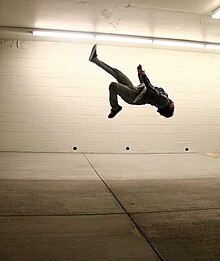|
Tricking (martial arts)
 Tricking is a training discipline that combines kicks with flips and twists from martial arts and gymnastics as well as many dance moves and styles from dance. It is not a martial art, though it borrows techniques from taekwondo, kung fu, wushu, capoeira, and more. It aims to achieve an aesthetic display of different combinations of "tricks". Tricking practitioners are commonly referred to as trickers. Examples of tricking techniques include the 540 kick, the corkscrew (cork), the flashkick, the butterfly twist and the double leg. HistoryA tendency to exhibit techniques that are more flashy and complex was observed in martial arts during the period following the 1960s, predating the current tricking movement. Especially in taekwondo, an increasing emphasis on spectacular spinning, jumping or flying kicks developed during the mid-1960s with the introduction of international competitions.[1] The actual sport of tricking is an internet phenomenon, emerging in the early 2000s.[citation needed] Xtreme Martial Arts is thought to be a close precursor to the sport, being shown at various martial arts tournaments in the 90s and early 2000s.[citation needed] By late 2003, the online tricking community was well-developed, bringing trickers from across the globe together. With the rise of YouTube, trickers were able to share their videos with others, and the discipline experienced a massive rise in popularity and interest.[citation needed] Progression Unlike many established sports, tricking has no formal rules or regulations, and there are no governing bodies that regulate the sport. Strictly speaking, participants are free to perform any kind of dramatic maneuver and call it a 'trick' - though there are certain moves that are generally accepted as tricking moves. Some practitioners (especially those who discover tricking through the Internet) tend to learn the easier moves first (such as the 540 kick, aerial, kip-up, and backflip) and try to progress through a list of recognized tricks in the perceived order of difficulty. However, how difficult a trick is, varies from person to person; certain tricks may be inexplicably easier or harder than normal for a particular tricker to learn. Trickers can be divided into different categories of style: some prefer performing mainly martial arts tricks (which almost always incorporate kicks into a trick), others mostly freestyle gymnastics and flips (mainly focus on combining different types of rotations and twists), but most trickers combine moves from both of the disciplines. Trickers regularly train their bodies hard to be able to perform their tricks at any time consistently. MechanicsIn traditional sports that contain rotational maneuvers, like gymnastics or high diving, twist rotation is mostly initiated using aerial twisting techniques.[2] Freestyle disciplines, including breakdancing, calisthenics, capoeira, contemporary dance, freestyle skiing, snowboarding, freerunning, tricking, are believed to mostly use contact twisting. A recent, yet unpublished study using motion capture data of over 300 tricking combos from multiple participants found that the horizontal (flip) and vertical (twist) components of the total angular momentum vector are exactly equal on average during Tricking, indicating a high degree of contact twisting. Contact twisting has the following advantages for tricking:
Trick Lists
See alsoReferences
|
|||||||||||||||||||||||||||||||||||||||||||||||||||||||||||||||||||||||||||||||||||||||||||||||||||||||||||||||||||||||||||||||||||||||||||||||||||||||||||||||||||||||||||||||||||||||||||